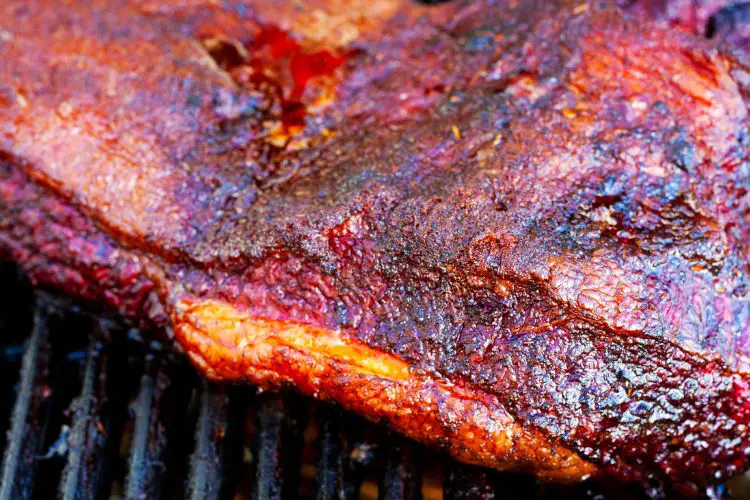Have you ever had the urge to smoke a brisket, but realized the one in your hand is frozen solid? Maybe an unexpected barbecue happened, or maybe you forgot to thaw it. With a frozen brisket in your hand, you stand there thinking, “Can You Smoke a Frozen Brisket?” You’re not the only one puzzled by this. We address a major query in this blog post
In this guide, we’ll dive straight into the answer, explore the challenges, and provide some helpful tips. So, whether you’re a seasoned smoker or a newbie, this guide is tailored for you.
Can You Smoke a Frozen Brisket?
Can you smoke a frozen brisket? The short answer is yes, you can. But while it’s technically possible, there are several challenges and considerations to keep in mind.
Longer Cooking Time
Starting with a frozen brisket will naturally extend the cooking time. It has to defrost and then reach the desired internal temperature. Depending on the size and thickness of the brisket, this could add several hours to your smoking process.
Uneven Cooking
A significant concern with smoking frozen meat is the potential for uneven cooking. The outer layers will start cooking and potentially overcooking before the innermost part has fully thawed. This could result in a brisket that’s charred on the outside and undercooked or even raw inside.
Moisture Issues
As the frozen brisket thaws, it will release water. This moisture can affect the formation of the “bark” or crust that many enthusiasts love on their smoked brisket. Excess water can prevent the bark from forming, leading to a softer or soggier exterior.
Flavor Challenges
Smoke penetration can be inconsistent in a frozen brisket. The smoke may not permeate the meat evenly, leading to an uneven smoky flavor. Additionally, applying rubs or marinades to frozen meat is less effective as they don’t adhere well to the frozen surface.
Safety First
From a food safety perspective, it’s crucial to ensure the brisket cooks thoroughly. The center of the brisket must reach a safe temperature to ensure all harmful bacteria are killed. Using a meat thermometer is essential when smoking a frozen brisket.
Quality and Texture
When smoked in a frozen state, brisket might not achieve the same tenderness as when it’s properly thawed first. The freezing and rapid heating process can change the meat’s cellular structure, sometimes resulting in a different mouthfeel.
Steps to Smoking a Frozen Brisket

If you find yourself in a situation where you need to smoke a frozen brisket, here’s a step-by-step guide to help you navigate the process and ensure you get the best possible result.
Preheat Your Smoker
Set your smoker to a slightly higher temperature than usual, around 275°F to 300°F. This higher heat will assist in the thawing process and help bring the brisket up to cooking temperature more efficiently.
Dry Off the Exterior
Before applying any rub, ensure you dry off the exterior of the frozen brisket with paper towels. This step will help your rub adhere better.
Apply Your Rub
Evenly coat the brisket with your preferred spice rub. Remember, some of it might fall off due to the moisture from thawing, so be generous.
Place the Brisket on the Smoker
Position the brisket fat side up. This allows the fat to render down and continuously baste the meat, providing extra moisture.
Monitor the temperature closely.
Insert a reliable meat thermometer into the thickest part of the brisket. This will allow you to keep an eye on the internal temperature, ensuring the brisket cooks evenly. Remember, you’re aiming for an internal temperature of around 190°F to 205°F for the meat to be tender and fully cooked.
Adjust Smoking Time
Understand that a frozen brisket will require a longer cooking time than a thawed one. Depending on its size and thickness, you might need to add several hours to the typical smoking time.
Baste or Spritz
To prevent the surface from drying out, consider basting or spritzing the brisket with a mixture of apple cider vinegar and water, or beef broth, especially in the early stages of cooking.
Rotate if Necessary
To ensure even cooking, you might need to rotate the brisket periodically. This is especially important if your smoker has hot spots.
Rest Before Slicing
Once the brisket reaches the desired internal temperature, remove it from the smoker and wrap it in aluminum foil or butcher paper. Let it rest for at least an hour. This allows the juices to redistribute throughout the meat, ensuring every slice is moist and tender.
Slice and Serve
Always slice against the grain for the most tender results. Enjoy your brisket with your favorite sides and sauces.
Step-by-Step Guide to Thawing a Frozen Brisket Using Cold Water:
Thawing a frozen brisket properly is crucial for both safety and quality reasons. Here’s a step-by-step guide on how to do it:
- Ensure your workspace and sink are clean to avoid cross-contamination.
- If the brisket isn’t already in a leak-proof plastic bag, transfer it into one. This prevents water from getting into the meat and potential bacterial growth.
- Use cold tap water to fill a sink or large basin enough to submerge the entire brisket.
- Place the bagged brisket into the cold water, ensuring it’s fully submerged. You may need to place a weight or heavy plate on top to keep it under the water if it tries to float.
- Change the Water: Every 30 minutes, drain and refill the sink or basin with fresh cold water to ensure continuous thawing. This also keeps the water temperature consistently cold, which is safer.
- Check for Thawing: Periodically check the brisket for softness by gently pressing it. Depending on the size and thickness, thawing can take several hours to half a day.
The Benefits of Taking the Time to Thaw a Brisket Properly
While it might be tempting to save time by smoking a frozen brisket, taking the time to thaw it properly offers numerous advantages. Not only will the brisket taste better and have a superior texture, but you’ll also ensure a safer and more efficient smoking experience. Here are the benefits of taking the time to thaw a brisket properly:
Enhanced Flavor and Tenderness: Thawing allows the meat fibers to relax, leading to better absorption of smoke and seasonings. This results in a richer and deeper flavor profile, allowing the brisket to showcase its natural taste.
Even Cooking: A properly thawed brisket cooks more uniformly. When you start with frozen meat, the outside might overcook by the time the inside reaches the desired temperature, leading to uneven doneness.
Improved Texture: The process of thawing ensures that the brisket retains its natural moisture, yielding a juicier end result. Frozen briskets can sometimes turn out dry due to the extended cooking time they require.
Better Smoke Penetration: Smoke adheres better to thawed meat surfaces than to frozen ones. Thawing ensures that the brisket gets that sought-after smoky aroma and flavor throughout.
Safety: Thawing meat properly reduces the risk of bacterial growth. When you smoke a frozen brisket, the prolonged time it spends in the “danger zone” temperature range can potentially allow harmful bacteria to multiply.
Efficient Cooking Time: While smoking a thawed brisket still takes hours, it’s quicker than smoking from frozen. You save time and fuel or wood in the long run.
FAQs
How much additional time does it take to smoke a frozen brisket compared to a thawed one?
Smoking a frozen brisket can add several hours to the typical smoking time. However, the exact additional time can vary based on the size and thickness of the brisket.
Does smoking a frozen brisket affect its flavor or texture?
Yes, smoking a frozen brisket can lead to uneven smoke penetration, which may result in inconsistent flavor. Additionally, the texture might be different, potentially lacking the tenderness achieved with a thawed brisket.
What’s the biggest challenge when smoking a frozen brisket?
One of the major challenges is achieving even cooking. The exterior might start cooking or even overcooking while the interior is still thawing, leading to an unevenly cooked brisket.
Do I need to adjust the temperature of my smoker when smoking a frozen brisket?
It’s a good idea to set the smoker at a slightly higher temperature initially to help with the thawing process, but always monitor the internal temperature of the meat to avoid overcooking.
Can I apply my regular rub or marinade to a frozen brisket?
While you can apply rubs or marinades to a frozen brisket, they might not adhere or penetrate as well as they would on a thawed brisket.
Is there a food safety risk associated with smoking a frozen brisket?
As long as the brisket reaches a safe internal temperature (around 190°F to 205°F), it should be safe to eat. Always use a reliable meat thermometer to check.
Conclusion
Smoking a frozen brisket is possible, but it comes with challenges. For the best flavor and texture, it’s ideal to thaw the brisket first. If you choose to smoke it frozen, monitor the temperature closely and be patient. Safety and taste should always come first.

